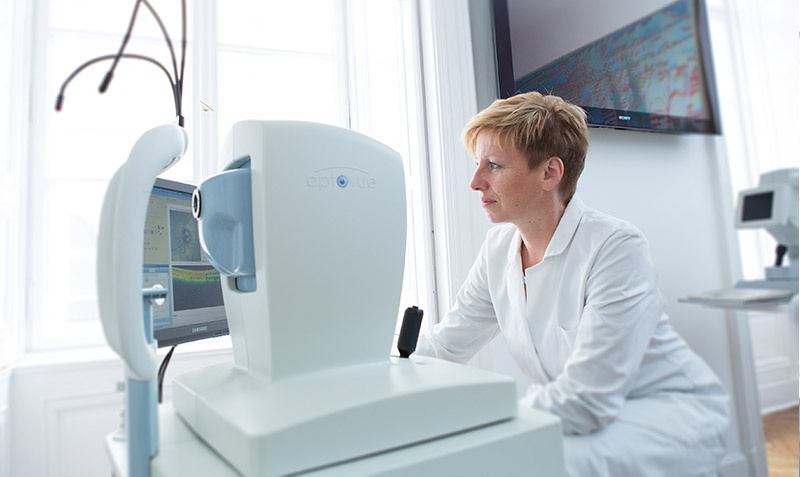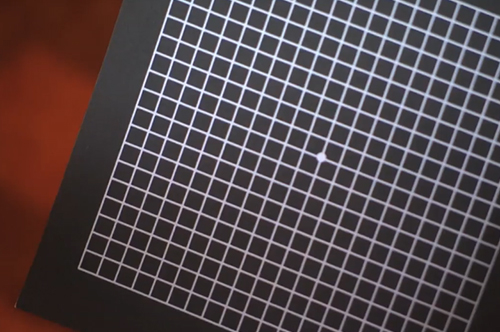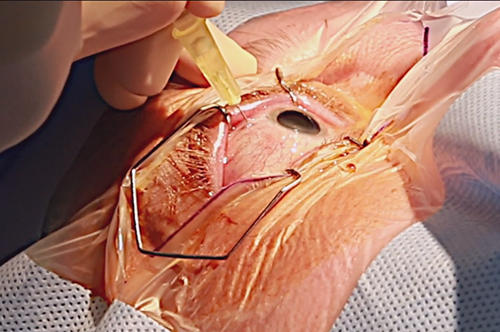Age related macula degeneration is devided into two types: the commonest form is the “dry” form of AMD, which results in gradual deterioration of visual acuity. The “wet” form of AMD is caused by swelling of the retina leading to distorted vision.
Diseases
Age-Related Macular Degeneration
Age-Related Macular Degeneration

What is the importance of the macula for vision?
The macula is the medical term for the centre of the retina which is in charge of high resultion vision. Objects we focus on are projected onto the macula. The visual input from the visual field is projected onto the peripheral parts of the retina. Therefore, our visual field is relatively large, but the central part for high definition vision is rather small.
How do we see?
The comparison to a photo camera does not entirely reflect the complexity of the eye, but it helps for a better understanding. Light reaches the retina (film) through the pupil (aperture) and the lens (lens of the camera). The retina is the inner layer of the eye ball. The choroid, which provides nutrients for the retina, is positioned behind it and is surrounded by the protective sclera.
The retina, in our analogy the film in the camera, contains millions of photoreceptors. These cells are stimulated by light. The optic nerve carries the information to the vision processing part of the brain.
The macula, an oval region of 2mm diameter in the centre of the retina, contains the highest amount of cones, which are the photoreceptor cells that allow high acuity vision and colour vision.
Starting at the edge of the macula and continuing towards the peripheral, outer parts of the retina, the amount of rods increases. The rods are primarily active during dawn and help us to orientate ourselves when it is nearly dark. The functioning of the rods is not affected by changes in the macula. Therefore, patients suffering from AMD usually keep their sense of orientation.
What are the typical causes for the disease?
Nowadays, an increasing number of people suffer from AMD. The reason for this increase is the fact that we live longer than our ancestors. The older we get, the higher the risk of developing age related macula degeneration with loss of central visual acuity.
So far, the causes for developing the disease have not been completely clarified. According to the latest causal research, AMD is not a direct result of disturbed blood flow in the choroid. Therefore, medications enhancing blood circulation can neither improve visual acuity nor have an influence on the course of disease. And likewise, unhealthy life style does not necessarily affect the development of AMD. Latest research proves that the conversion of light impulses in the photoreceptors is a photo chemical process, producing waste products. These have to be disposed by the eye. It appears that the eye cannot cope with this process with increasing age. Light is considered to be a prime factor for developing AMD. This is supported by the higher incidence of AMD among patients with light eye colour than those with darker pigmented eyes.
Age related macula degeneration is devided into two types: the commonest form is the “dry” form of AMD, which results in gradual deterioration of visual acuity. Sometimes, the disease progresses over a longer period of time, so that some patients can continue reading with optical or electronic devices up to old age. Despite intensive worldwide research, no effective drugtherapy or other forms of treatment are available for dry AMD.
The “wet” form of AMD is caused by swelling of the retina leading to distorted vision. Straight lines appear wavy. For instance, patients report seeing straight objects, such as window frames, distorted. Sometimes, these symptoms are not noticed early enough. Because of the possible rapid course of disease, regular check ups by an ophthalmologist are necessary. The swelling of the retina is caused by abnormal blood vessel growth from the choroid into the retina, destroying its photoreceptors.
The dry form of age related maculadegeneration can pass into the wet form of AMD at any time. Therefore, regular check ups by the ophthalmologist are essential.
What are the first symptoms?
Age-related macula degeneration is not painful. First signs usually become noticeable during reading. In the middle of the text, at the position the patient tries to focus, there is a shadow. In the beginning, only a few letters are missing, but over time the shadow increases in size. During the advanced state of the disease, the patient cannot recognise faces anymore. In most cases, some vision remains. Usually, dim silhouettes and contrasts can still be recognised, which means that the patients are not totally blind.
Are treatments available?
Possible treatment depends on the type and severity of your AMD. There are a number of new therapy plans. However, they are still in the state of clinical trials and their effectiveness has not been proven completely, for example: treatment with agents causing regression of the abnormal blood vessel growth. Surgical removement of vessels and bleeding. Surgical rotation of the retina and laser treatment after dispensing a substance sensitizing the blood vessels. Prof. Findl will explain the efficacy of any treatment according to the state of your disease. Nevertheless, a cure for AMD has not yet been found. Experiments with an artificial, electronic retina (retina chip) are in progress, though the application of this techinique has not been possible in the human eye yet.
How is AMD diagnosed?
The ophthalmologist can diagnose changes in the centre of the retina before symptoms show. The following examinations are used to clarify the progress of the AMD:
Amsler Grid Test (see below)
Fluorescein angiography allows for the identification and localisation of abnormal vascular processes. After injecting a colouring substance into the vein in the arm, abnormal blood vessels at the back of the eye are made visible.
Amsler Grid Test
You can test the function of your macula using the so called “Amsler Grid Test”. Early changes in vision, that might be otherwise neglected, can be detected. It is recommended to repeat this self test every 2 to 3 weeks.
Which devices can improve vision?
Only in the early stage of age related macula degeneration, stronger reading glasses will improve vision. Nevertheless, there are special reading devices known as low vision aids that magnify the image. Both optical and electronic magnifying devices enable most patients to continue reading, though the patient needs a lot of patience and a strong will to overcome the considerable difficulties. The more the image is magnified by the low vision aid, the smaller the visual field. But whoever has enjoyed reading will put up with the strenuous initial time of adaptation and will stay independant.
Despite the technical progress in the field of low vision aids, not all the patients manage to adapt with the chosen system. Although the state and progression of the disease are important, so is the general condition of the patients, their resiliance, motivation and life styles.
Does AMD result in blindness?
As the photoreceptors around the macula are not destroyed by AMD, patients usually obtain their sense of orientation. Even in the late stages of the disease, when central vision is totally lost, contrasts and silhouettes can still be detected. This means, that AMD does not result in total blindness. However, according to Austrian law, a patient is considered as blind and entitled for blind-benefit.



